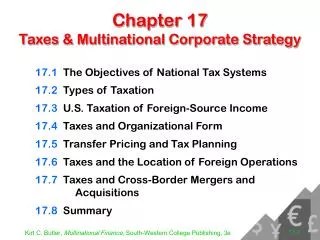Chapter 17
Chapter 17. Management Control Systems and Responsibility Accounting. Describe the relationship of management control systems to organizational goals. Learning Objective 1. Management Control System. What is a management control system?. It is a logical integration of techniques
Share Presentation
Embed Code
Link
Download Presentation
- survey scores
- t universal card services
- statistical plot
- planning
- considerable ground
- financial strength product profitability

scot + Follow
Download Presentation
Chapter 17
An Image/Link below is provided (as is) to download presentation Download Policy: Content on the Website is provided to you AS IS for your information and personal use and may not be sold / licensed / shared on other websites without getting consent from its author. Content is provided to you AS IS for your information and personal use only. Download presentation by click this link. While downloading, if for some reason you are not able to download a presentation, the publisher may have deleted the file from their server. During download, if you can't get a presentation, the file might be deleted by the publisher.
Presentation Transcript
- Chapter 17 Management Control Systems and Responsibility Accounting
- Describe the relationship of management control systems to organizational goals. Learning Objective 1
- Management Control System What is a management control system? It is a logical integration of techniques to gather and use information. Planning and Control Motivate Evaluate
- Management Control System Set Goals, Measures, Targets Plan and Execute Feedback and Learning Evaluate, Reward Monitor, Report
- Setting Goals, Objectives, and Performance Measures Top management develops organization-wide goals, measures, and targets. They also identify the critical processes needed to achieve the goals. Top management and critical process managers develop key success factors and performance measures. They also identify specific objectives.
- Setting Goals, Objectives, and Performance Measures Critical process managers and lower-level managers develop specific performance measures for each objective.
- Organizational Goals A well-designed management control system aids and coordinates the process of making decisions and motivates individuals throughout the organization to act in concert.
- Critical Process A criticalprocess is a series of related activities that directly affect the achievement of organizational goals.
- Key Success Factors • Key success factors are actions that must be done well in order to drive the organization towards its goals.
- Use responsibility accounting to define an organizational subunit as a cost center, a profit center, or an investment center. Learning Objective 2
- Responsibility Center • A responsibility center is a set of activities assigned to a manager, a group of managers, or other employees.
- Responsibility Accounting • Responsibility accounting is used to identify what parts of the organization have primary responsibility for each objective, develop performance measures and targets to achieve, and design reports of these measures by organization subunit or responsibility center.
- Types of Responsibility Centers A cost center’s manager is accountable for costs only. Profit centers have responsibility for controlling revenues as well as costs. Investment centers have responsibility for revenues, expenses, and the investment used by the center.
- Compare financial and nonfinancial performance, and explain why planning and control systems should consider both. Learning Objective 3
- Measures of Performance Good performance measures will… relate to the goals of the organization. balance long-term and short-term concerns. reflect the management of key actions and activities. be readily understood by employees.
- Measures of Performance be affected by actions of managers and employees. be used in evaluating and rewarding managers and employees. be reasonably objective and easily measured. be used consistently and regularly.
- Nonfinancial Measures of Performance • AT&T Universal Card Services uses 18 performance measures for its customer inquiries process. • These measures include average speed of answer, abandon rate, and application processing time.
- Nonfinancial Measures of Performance Often the effects of poor nonfinancial performance do not show up in the financial measures until considerable ground has been lost. quality productivity satisfaction
- Monitoring and Reporting Results • Feedback and learning are at the center of the management control system. • At all points in the planning and control process, it is vital that effective communication exists among all levels of management and employees.
- A Successful Organization and Measures of Achievement FINANCIAL STRENGTH Product Profitability, EBIT CUSTOMER SATISFACTION Market Share, Survey Scores, Complaints BUSINESS PROCESS IMPROVEMENT Cycle Time, Defects, Activity Costs ORGANIZATIONAL LEARNING Training Time, Turnover, Staff Satisfaction Score
- The Balanced Scorecard A balanced scorecard is a performance measurement and reporting system that strikes a balance between financial and operating measures. It links performance to rewards. It gives explicit recognition to the diversity of organizational goals.
- The Balanced Scorecard The scorecard measures an organization’s performance from four key perspectives: Financial strength Business processes improvement Customer satisfaction Organizational learning
- Key Performance Indicators What are key performance indicators? They are measures that drive the organization to achieve its goals.
- Explain the importance of evaluating performance and how it impacts motivation, goal congruence, and employee effort. Learning Objective 4
- Goal Congruence Goal congruence exists when individuals and groups aim at the same organizational goals. It is achieved when employees, working in their own perceived best interests, make decisions that help meet the overall goals of the organization.
- Managerial Effort… is exertion toward a goal or objective. Planning Supervising Thinking
- Motivation… is a drive for some selected goal. It creates action toward that goal. It creates effort.
- Prepare segment income statements for evaluating profit and investment centers using the contribution margin and controllable-cost concepts. Learning Objective 5
- Controllability Management Control System Controllable events Uncontrollable events Controllable costs Uncontrollable costs
- Controllability Controllable costs include any costs that are influenced by a manager’s decisions and actions. An uncontrollable cost is any cost that cannot be affected by the management of a responsibility center within a given time span.
- Contribution Margin • The contribution margin is especially helpful for predicting the impact on income of short-run changes in activity volume. • Managers may quickly calculate any expected changes in income by multiplying increases in dollar sales by the contribution margin ratio.
- Segments Segments are responsibility centers for which a separate measure of revenues and costs is obtained.
- Segments East Division West Division Total Net sales $950,000 $1,950,000 $2,900,000 Variable costs 750,000 950,000 1,700,000 Contribution margin $200,000 $1,000,000 $1,200,000 Controllable costs 75,000 60,000 135,000 Segment margin $125,000 $ 940,000 $1,065,000 Allocated costs 70,000 80,000 150,000 Income $ 55,000 $ 860,000 $ 915,000 Unallocated costs 300,000 Organization profit $ 615,000
- Measure performance against quality, cycle time, and productivity objectives. Learning Objective 6
- Quality Control Quality control is the effort to ensure that products and services perform to customer satisfaction.
- Cost of Quality Report • In a cost of quality report, the financial impact of quality is displayed. Prevention Internal failure Appraisal External failure
- Cost of Quality Report Prevention costs are the costs incurred to prevent the production of defective products or delivery of substandard services. Appraisal costs are the costs incurred to identify defective products or services.
- Cost of Quality Report Internal failure costs are the costs of defective components and final products or services that are scrapped or reworked. External failure costs are the costs caused by delivery of defective products or services to customers, such as field repairs, returns, and warranty expenses.
- Quality-Control Chart • The quality-control chart is a statistical plot of measures of various product dimensions or attributes. • This plot helps detect process deviations before the process generates defects.
- Quality-Control Chart
- Cycle Time Cycle time, or throughput time, is the time taken to complete a product or service, or any of the components of a product or service. One key to improving quality is to reduce cycle time.
- Control of Cycle Time • Lowering cycle time requires smooth-running processes and high quality, and also creates increased flexibility and quicker reactions to customer needs.
- Productivity • Productivity is a measure of outputs divided by inputs. • Productivity measures vary widely according to the type of resource with which management is concerned.
- Control of Productivity More than half the companies in the United States manage productivity as part of the effort to improve their competitiveness.
- Control of Productivity • How should outputs and inputs be measured? • Labor-intensive organizations are concerned with increasing the productivity of labor, so labor-based measures are appropriate.
- Control of Productivity • Highly automated companies are concerned with machine use and productivity of capital investments, so capacity-based measures, such as the percentage of time machines are available, may be most important to them.
- Describe the difficulties of management control in service and nonprofit organizations. Learning Objective 7
- Service, Government, and Nonprofit Organizations • Most service, government, and nonprofit organizations have more difficulty implementing management control systems. • Why?
- Service, Government, and Nonprofit Organizations Outputs of service and nonprofit organizations are more difficult to measure than are the cars or computers that are produced by manufacturers.
- Understand how a management control system uses accounting information. Learning Objective 8 Load More .

Chapter 17
Chapter 17 Menu Nature of Motor Vehicle Theft Legal Aspects of Motor Vehicle Theft Investigating Motor Vehicle Theft Scenario- One Less Car Motor Motor Vehicle Motor Vehicle Theft Nature of Motor Vehicle Theft A separate crime in the FBI’s index offenses
1.85k views • 88 slides

Chapter 17
Chapter 17. Financial Management. Learning Objectives. To understand how value is measured and managed across the multiple units of the multinational firm.
559 views • 24 slides

Chapter 17
17.5 Transfer Pricing and Tax Planning. 17.6 Taxes and the Location of . The objectives of tax neutrality. Domestic tax neutrality - incomes arising from domestic .
687 views • 27 slides

Chapter 17
Chapter 17. Managing the Sales Force. PowerPoint by Karen E. James Louisiana State University - Shreveport. Objectives. Review the types of decisions firms face in designing a sales force. Learn how companies recruit, select, train, supervise, motivate, and evaluate a sales force.
530 views • 17 slides

Chapter 17
Chapter 17. The Creation and Diffusion of Consumer Culture. Culture Production Process. The set of individuals and organizations responsible for creating and marketing a cultural product is a Cultural Production System (CPS) . It consists of:
619 views • 25 slides

Chapter 17
Chapter 17. Current and Resistance. André-Marie Ampère 1775 – 1836. Electric Current. Let us look at the charges flowing perpendicularly to a surface of area A The electric current is the rate at which the charge flows through this surface
415 views • 24 slides

Chapter 17
Chapter 17. Computer Security. Chapter Goals. Discuss the CIA triad List three types of authentication credentials Create secure passwords and assess the security level of others Define categories of malware List the types of security attacks Define cryptography. Chapter Goals.
705 views • 31 slides

Chapter 17
Chapter 17. Methodology Logical Database Design for the Relational Model. Step 2 Build and Validate Logical Data Model.
754 views • 31 slides

Chapter 17
Chapter 17. Please pick up a handout from the table in the back of the auditorium for class this morning. Vital Concepts & Truths to Know in John 17. Jesus has authority over all (John 17:2; cf. Matt. 28:18)! He alone has the power to offer salvation & eternal life on His conditions.
235 views • 12 slides

Chapter 17
Chapter 17. Current and Resistance. Bright Storm on Electric Current. Read and take notes on pages 531-534 in Conceptual Physics Text Or lesson 2 C E lectric C urrent on Physics Classroom. Read and take notes on pages 570-571 in College Physics Text. Current.
954 views • 75 slides

Chapter 17
Chapter 17 . Microevolutionary Process. Where we left off. Darwin had come up with a mechanism for evolution called natural selection. It seemed to explain what had happened over long periods of time, based on the fossil evidence
314 views • 17 slides

CHAPTER 17
CHAPTER 17. Process Costing. Edited by Dr. Charles Bailey for ACCT7310. Job versus Process Costing. Job-Costing Systems Distinct, identifiable units of a product or service Examples: Custom-made machines, houses. Process-Costing Systems Masses of identical or similar units of a
551 views • 27 slides

Chapter 17
Chapter 17. Auction-based spectrum markets in cognitive radio networks. Outline. Rethinking Spectrum Auctions On-demand Spectrum Auctions Economic-Robust Spectrum Auctions Double Spectrum Auctions for Multi-party Trading Chapter Summary Further Reading. Recent Spectrum Auction Activities.
1.5k views • 29 slides

Chapter 17
Chapter 17. Equilibrium. 17.1 Reaction Rates and Equilibrium. To understand the collision model of chemical reactions To understand activation energy To understand how a catalyst speeds up a chemical reaction To explore reactions with reactants or products in different phases
627 views • 48 slides

Chapter 17
Chapter 17. Current and Resistance. Example 17.3 – Page 578. A) Calculate the resistance per unit length of a 22-gauge nichrome wire of radius 0.321mm. B) If a potential difference of 10V is maintained across a 1m length of the nichrome wire, what is the current in the wire?
330 views • 14 slides

Chapter 17
Chapter 17. Current and Resistance. Electric Current. Whenever electric charges of like signs move, an electric current is said to exist The current is the rate at which the charge flows through this surface Look at the charges flowing perpendicularly to a surface of area A
713 views • 58 slides

Chapter 17
Chapter 17. Lauren Mangus, Ashlee Stants , Isabella Condie , Maleah Grabiak , Allegra Shaffer. That’s so Raven. The Purpose of Our clip…. Q: Do you have any ideas on why we chose an episode of “That’s so Raven”?
300 views • 13 slides

Chapter 17
Chapter 17. Integrated and Differentiated Services. Introduction. New additions to Internet increasing traffic High volume client/server application Web Graphics Real time voice and video Need to manage traffic and control congestion IEFT standards Integrated services
734 views • 49 slides

Chapter 17
Chapter 17. Overview.
463 views • 16 slides

CHAPTER 17
Object-Oriented and Classical Software Engineering Eighth Edition, WCB/McGraw-Hill, 2011 Stephen R. Schach. CHAPTER 17. MORE ON UML. Chapter Overview. UML is not a methodology Class diagrams Notes Use-case diagrams Stereotypes Interaction diagrams Statecharts Activity diagrams
1.08k views • 75 slides

CHAPTER 17
CHAPTER 17. THEORIES, MODELS, and FRAMEWORKS. Objectives. Discuss the relationship between healthcare informatics and nursing informatics. Discuss different definitions and models of nursing and healthcare informatics. Discuss core concepts and the scope of practice of nursing informatics.
377 views • 33 slides

Chapter 17
Chapter 17. Epilogue: Fitting the Pieces Together. One year from now, we may find that we have forgotten more than 50 % of what learned from this class. What’s important is the big picture and major principles which we can use in the future. Human Development is a Holistic Enterprise.
298 views • 25 slides
























